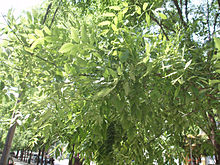Styphnolobium
| Styphnolobium | |
|---|---|
 |
|
| Styphnolobium japonicum foliage | |
| Scientific classification | |
| Kingdom: | Plantae |
| (unranked): | Angiosperms |
| (unranked): | Eudicots |
| (unranked): | Rosids |
| Order: | Fabales |
| Family: | Fabaceae |
| Subfamily: | Faboideae |
| Genus: |
Styphnolobium Schott |
| Type species | |
|
Styphnolobium japonicum (L.) Schott |
|
| Species | |
|
9; see text. |
|
| Synonyms | |
|
|
9; see text.
Styphnolobium is a small genus of three or four species of small trees and shrubs in the subfamily Faboideae of the pea family Fabaceae, formerly included within a broader interpretation of the genus Sophora. It was recently assigned to the unranked, monophyletic Cladrastis clade. They differ from the genus Calia (mescalbeans) in having deciduous leaves and flowers in axillary, not terminal, racemes. The leaves are pinnate, with 9–21 leaflets, and the flowers in pendulous racemes similar to those of the black locust. Necklacepod is a common name for plants in this genus.
From Greek styphno-, stryphno- "sour, astringent" and lobion "pod", because of the fresh pods' pulp taste.
Styphnolobium comprises the following species:
The Pagoda Tree is widely used in bonsai gardening. The Guilty Chinese Scholartree was a historic Pagoda Tree in Beijing, on which the last emperor of the Ming Dynasty, Chongzhen, hanged himself.
S. japonicum (Chinese: ; pinyin: huái; formerly Sophora japonica) is one of the 50 fundamental herbs used in traditional Chinese medicine.
...
Wikipedia
